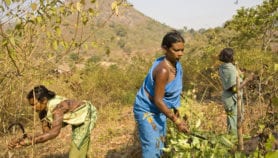By: T.V. Padma
Send to a friend
The details you provide on this page will not be used to send unsolicited email, and will not be sold to a 3rd party. See privacy policy.
[NEW DELHI] Indian nightshade, a herb used in the traditional ayurvedic system of Indian medicine, can effectively control mosquitoes and could help curb malaria, according to new research.
Scientists from the Desert Medicine Research Centre in Jodhpur found that extracts of the roots and fruits of the plant Solanum xanthocarpum are lethal to larvae of three mosquito species.
The plant’s active ingredient should now be identified and used, if possible, to prepare an insecticide against mosquito larvae, the scientists say. This could provide an alternative to current strategies, which use chemicals to control mosquitoes that carry the malaria parasite.
The study, by Karam Vir Singh and SK Bansal, shows that the plant had a lethal effect on the malaria vectors Anopheles culicifacies and Anopheles stephensi, and also on Aedes aegypti, which transmits dengue fever. The fruit extract was up to 16 times more potent than the root extract.
“As the plant is distributed throughout the country and the fruits are available most of the time, the larvicidal properties can be well utilised while planning alternate vector control strategies,” the researchers write in the Indian journal Current Science.
"The plant is easily available to the local people and being an ayurvedic herb with multiple medicinal properties, it may be easily acceptable to them, since during application it would neither cause any toxic effect nor any additional economic burden."
Screening plants for anti-mosquito properties, however, is only one step forward in a long road to malaria control, cautions Vinod Prakash Sharma, former director of the Malaria Research Centre in Delhi and pioneer of a combination of biological and environmental malaria control strategies in India.
Sharma argues that spraying chemical insecticides is not an effective malaria control strategy. Repeated spraying makes mosquitoes resistant, leading to an increase in the use of toxic and expensive insecticides. “Chemical spraying is a one-way street with an end," he says. "India has reached that end”.
Instead, Sharma proposes a bioenvironmental strategy, based on identification and elimination of mosquito-breeding sources such as ditches, pits, drains and water-storage tanks. The use of larvae-eating fishes is also showing promise, he says.
A study in the South Indian state of Karnataka found that 400 villages that used these bioenvironmental strategies remained malaria-free for 10 years. In contrast, high levels of malaria have persisted in villages that relied on spraying pesticides for malaria control.
Source: SciDev.Net
See also:













